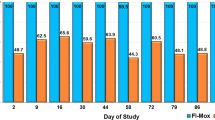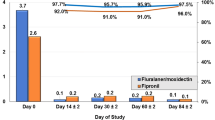Abstract
This paper describes the design and the preliminary evaluation of an integrated approach to the control of Echinococcus multilocularis in foxes using praziquantel bait. Air distribution of bait in agricultural and recreational areas was combined with distribution of bait by hand in towns and villages to cover the entire fox population in the 213-km2 baiting area. Bait distribution density was 50/km2, and bait was distributed once every 4 weeks. Pre-baiting prevalence was 35% (22–50% CI 95%). During a 1-year period following the first 4 months of bait distribution, only one positive fox was found (prevalence 1%; 0–4% CI 95%). No significant change had occurred in the unbaited control area. This prevalence decline is far more pronounced than in previous fox-baiting studies, which is likely to be due to the increased bait distribution density and baiting frequency, and the inclusion of the ‘urban’ fox population.


Similar content being viewed by others
References
Andrews P, Thomas H (1983) Praziquantel. Med Res Rev 3:147–200
Ansorge H (1990) Populationsökologische Aspekte der Bestandsdynamik des Rotfuchses in der DDR. In: Commichau C, Sprankel H (eds) Fuchssymposium Koblenz 2.–3. März 1990, Verlag Neumann-Neudamm, Melsungen, pp 49–54
Barla-Szabo B (2002) Habitatuntersuchungen von Füchsen im urbanen Bereich anhand des Fallbeispiels Grünwald München, LMU-München, Fakultät für Biologie, Diplomarbeit
Bayerisches Landesamt für Gesundheit und Lebensmittelsicherheit, LGL (2007) Statistics. Dienststelle Oberschleißheim, Oberschleißheim
Bellebaum J (2003) Bestandsentwicklung des Fuchses in Ostdeutschland vor und nach der Tollwut. Z Jagdwiss 49:41–49
Braunschweig A (1976) Wildkrankheiten. Landbuch Verlag, Hannover
Breitenmoser-Würsten C, Robin K, Landry J-M, Gloor S, Olsson P, Breitenmoser U (2001) Die Geschichte von fuchs, Luchs, Bartgeier, Wolf und Braunbär in der Schweiz-ein kurzer Überblick. Forest Snow Landsc Res 76(1/2):9–21
Cannon RM, Roe RT (1990) Krankheitsüberwachung in Tierbeständen (Infection control in life stock) (deutsche Übersetzung und Bearbeitung von RJ Lorenz). AID, Bonn
Chautan M, Pontier D, Atois M (2000) Role of rabies in recent demographic changes in Red fox (Vulpes vulpes) populations in Europe. Mammalia 64(4):391–410
Daugschies A (1995) Aktuelles zur Epidemiologie und Bekämpfung des Fuchsbandwurmes, Echinococcus multilocularis, in Deutschland. Dtsch Tierärztl Wschr 102:299–338
Eckert J, Deplazes P (1999) Alveolar echinococcosis in humans: the current situation in central Europe and the need for countermeasures. Parasitol Today 15:315–319
Eckert J, Deplazes P, Craig PS, Gemmell MA, Gottstein B, Heath D, Jenkins DJ, Kamiya M, Lightowlers M (2001) Echinococcosis in animals: clinical aspects, diagnosis and treatment. In: Eckert J, Gemmell MA, Meslin FX, Pawlowski ZS (eds) WHO/OIE manual on echinococcosis in humans and animals: a public health problem of global concern. World Organization for Animal Health, Paris, pp 72–99
Funk SM, Gürtler WD (1990) Über den Zusammenhang zwischen Reproduktionserfolg und Populationsdichte beim Rotfuchs, Vulpes vulpes L. In: Commichau C, Sprankel H (eds) Fuchssymposium Koblenz 2.–3. März 1990, Verlag Neumann-Neudamm, Melsungen, pp 39–48
Gerards HH (2005) Was wissen wir über die Ausbreitung der Infektion mit dem Kleine Fuchsbandwurm? In: Bayer. Akademie d. Wissenschaften (Hrsg.) Rundgespräche der Kommission für Ökologie, Band 29: Zur Ökologie von Infektionskrankheiten: Borreliose, FSME und Fuchsbandwurm. Verlag Dr. Friedrich Pfeil, München, pp 63–68
Gloor S, Bontadina F, Hegglin D, Deplazes P, Breitenmoser U (2001) The rise of urban fox populations in Switzerland. Mamm Biol 66:155–164
Goretzki J (1996): Zur Populationsentwicklung des Rotfuchses in der Bundesrepublik Deutschland. In: Tackmann K, Janitschke K (eds) Zur epidemiologischen situation des Echinococcus multilocularis-breitet sich eine gefährliche Parasitose in der Bundesrepublik Deutschalnd aus? Robert Koch-Institut, RKI Hefte 14, pp 26–29
Hansen F, Thulke HH, Jeltsch F (2003) Simulationsmodelle zur Planung von Strategien in der Bekämpfung von Wildtiererkrankungen. Forum Geoökol 14:20–22
Harris S (1977) Distribution, habitat utilization and age structure of a suburban fox (Vulpes vulpes) population. Mamm Rev 7(1):25–39
Harris S (1979) Age-related fertility and productivity in Red foxes, Vulpes vulpes, in suburban London. J Zool Lond 187:195–199
Harris S (1981) An Estimation of the number of foxes in the city of Bristol, and some possible factors affecting their distribution. J Appl Ecol 18:455–465
Harris S, Rayner JMV (1986) Urban fox (Vulpes vulpes) population estimates and habitat requirements in several British cities. J Anim Ecol 55:575–591
Hegglin D, Ward P, Deplazes P (2003) Anthelmintic baiting of foxes against urban contamination with Echinococcus multilocularis. Emerg Infect Dis 9(10):1266–1272
Hegglin D, Bontadina F, Gloor S, Romer J, Müller U, Breitenmoser U, Deplazes P (2004) Baiting red foxes in an urban area: a camara trap study. J Wildl Manage 68(4):1010–1017
Heibl C (2002) Das Raum-Zeit-Verhalten von Rotfüchsen Vulpes vulpes in suburbanem Gebiet, Gemeinde Grünwald bei München. Freising, Forstwissenschaftliche Fakultät, Fachgebiet Wildbiologie und Wildtiermanagement, Technischen Universität München, Diplomarbeit
Hildenband R (2006) Anwendung und Evaluierung eines Losungszählverfahrens beim Rotfuchs (Vulpes vulpes) im Stadtrandbereich Starnberg. Diplomarbeit Fakultät für Biologie, LMU-München
Hofer S, Gloor S, Müller U, Mathies A, Hegglin D, Deplazes P (2000) High prevalence of Echinococcus multilocularis in urban red foxes (Vulpes vulpes) and voles (Arvicola terrestris) in the city of Zürich, Switzerland. Parasitology 120:135–142
Ito A, Romig T, Takahashi K (2003) Perspective on control options for Echinococcus multilocularis with particular reference to Japan. Parasitology 127:159–172
Kaphegyi T (2002) Untersuchungen zum Sozialverhalten des Rotfuchses (Vulpes vulpes L.) Inaugural-Dissertation zur Erlangung der Doktorwürde der Forstwissenschaftlichen Fakultät der Albert-Ludwigs-Universität Freiburg i. Brsg
Kern P, Ammon A, Kron M, Sinn G, Sander S, Petersen LR, Gaus W, Kern P (2004) Risk factors for alveolar echinococcosis in humans. Emerg Infect Dis 10(12):2008–2093
König A (2005) Neue Untersuchungsergebnisse zur Ausbreitung des Kleinen Fuchsbandwurms (Echinococcus multilocularis) im Großraum München. In: Bayer. Akademie d. Wissenschaften (Hrsg.) (ed) Rundgespräche der Kommission für Ökologie, Band 29: Zur Ökologie von Infektionskrankheiten: Borreliose, FSME und Fuchsbandwurm. Verlag Dr. Friedrich Pfeil, München, pp 71–84
König A, Barla-Sabo B (2005) Urban foxes: Where do they live and have breakfast. In: Pohlmeyer K XXVIIth Congress of the International Union of Game Biologists Extended Abstracts, Hannover, Germany 28.8.–3.9.2005, pp 136–137
König A, Romig T, Thoma D, Kellermann K (2005) Drastic increase in the prevalence of Echinococcus multilocularis in foxes (Vulpes vulpes) in southern Bavaria, Germany. E J Wildl Res 51:277–282
Labhardt F (1996) Der Rotfuchs. Verlag Paul Parey, Hamburg, 158 S
Macdonald D (1993) Unter Füchsen. Eine Verhaltensstudie. Knesebeck Verlag, München
Marks CA, Bloomfield TE (1999) Distribution and density estimates for urban foxes (Vulpes vulpes) in Melbourne: implications for rabies control. Wildl Res 26:763–775
Notdurft HD, Jelinek T, Mai B, Sigl B, v Sonnenburg F, Löscher T (1996) Epidemiologie der alveolären Echinokokkose in Süddeutschland (Bayern). In: Tackmann K, Janitschke K (eds) Zur epidemiologischen Situation des Echinococcus multilocularis-breitet sich eine gefährliche Parasitose in der Bundesrepublik Deutschalnd aus? Robert Koch -Institut, RKI Hefte 14, pp 41–43
Romig T, Bilger B, Merli M, Dinkel A, Lucius R, Mackenstedt U (1999) Bekämpfung von Echinococcus multilocularis in einem Hochendemiegebiet Süddeutschlands. In: Neuere Methoden und Ergebnisse zur Epidemiologie von Parasitosen, Tagung der Fachgruppe Parasitologie und parasitätre Krankheiten, Hannover, 10.–12.3.1999. Tagungsbericht, DVG, Giessen, pp 172–183
RRZN (2001) SPSS Fortgeschrittene. Hannover
Schelling U, Frank W, Will R, Romig T, Lucius R (1997) Chemotherapy with praziquantel has the potential to reduce the prevalence of Echinococcus multilocularis in wild foxes (Vulpes vulpes). Ann Trop Med Parasitol 91:179–186
Schneider LG (1990) Der Einfluß der oralen Immunisiewrung der Füchse auf die Epidemiologie der Tollwut. In: Commichau C, Sprankel H (eds) Fuchssymposium Koblenz 2.–3. März 1990, Verlag Neumann-Neudamm, Melsungen, pp 145–164
Schweiger A, Ammann RW, Candinas D, Clavien P-A, Eckert J, Gottstein B, Halkic N, Muellhaupt B, Prinz BM, Reichen J, Tarr PE, Torgerson PR, Deplazes P (2007) Human Alveolar echinoccosis after fox population increase, Switzerland. Emerg Infect Dis 13(6):878–882
Stachowiak H (1973) Allgemeine modelltheorie. Springer, Berlin, p 494
Stiebling U (2000) Untersuchungen zur Habitatnutzung des Rotfuchses, Vulpes vulpes (L. 1758), in der Agrarlandschaft als Grundlage für die Entwicklung von Strategien des Natur- und Artenschutzes sowie der Tierseuchenbekämpfung. Dissertation, Humboldt-Universität Berlin
Stubbe H (ed) (1986) Buch der Hege, Haarwild. Verlag Harri Deutsch, Thun-Frankfurt a.M
Tackmann K, Löschner U, Mix H, Staubach C, Thulke HH, Ziller M, Conraths FJ (2001) A field study to control Echinococcus multilocularis infections of the red fox (Vulpes vulpes) in an endemic focus. Epidemiol Infect 127:577–587
Trappmann D (2007) Erfassung der Populationsdichte beim Rotfuchs anhand von Raum- und Strukturdaten im Landkreis Starnberg. Bachelor’s Thesis, Studienfakultät für Forstwissenschaft und Ressourcenmanagement, Technische Universität München, Freising
Vos A (1990) Untersuchung zur Entwicklung der Fuchspopulation nach erfolgreichem Abschluss der oralen Immunisierung gegen die Tollwut. Fuchssymposium Koblenz 2.–3.3. 1990, Schriftenreihe des Arbeitskreise Wildbiologie der Justus-Liebig-Universität Giesen, 20:145–165
Vos A (1993) Aspekte der Dynamik einer Fuchspopulation nach dem Verschwinden der Tollwut. Dissertation zur Erlangung der Doktorwürde der Forstwissenschaftlichen Fakultät der Ludwig-Maximilians-Universität München
Acknowledgments
This project was financed by the communities of Andechs, Herrsching, Gauting, Krailling, Planegg, Pöcking, Seefeld, and the town of Starnberg. We would very much like to thank the mayors, as representatives of the communities, for their support. Without the cooperation of the residents and local hunters, represented by Mr. Frömmel, this project would not have been successful. Our thanks to you also. Special thanks go to Dr. Kopp from the Bavarian State Institute for Public Health (Bayerisches Landesamt für Gesundheit und Lebensmittelsicherheit, LGL) for his support on data collection of dissected foxes.
Author information
Authors and Affiliations
Corresponding author
Additional information
Communicated by F.-J. Kaup
Rights and permissions
About this article
Cite this article
König, A., Romig, T., Janko, C. et al. Integrated-baiting concept against Echinococcus multilocularis in foxes is successful in southern Bavaria, Germany. Eur J Wildl Res 54, 439–447 (2008). https://doi.org/10.1007/s10344-007-0168-1
Received:
Revised:
Accepted:
Published:
Issue Date:
DOI: https://doi.org/10.1007/s10344-007-0168-1




